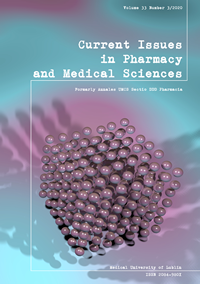Comparative analysis of the nerve transfer methodologies used during surgical treatment of peripheral facial paresis
DOI:
https://doi.org/10.2478/cipms-2020-0025Keywords:
nerve transfer, facial nerve, surgical treatment, electroneuromyography, donor nerveAbstract
Introduction. When considering the array of biomedical problems associated with facial nerve palsy (FNP), it is apparent that the problem of choosing an effective type of facial nerve transfer is of paramount relevance. Hence, it is to the pursuit of a solution to the above stated problem that our study is devoted.
Materials and methods. We analyzed the data obtained as a result of assessing the outcome of 149 patients with trauma-caused FNP who had undergone surgical treatments in the period between 2001-2018. The FN nerve transfer techniques utilized were as such: for group 1 – the use as a donor nerve the branch of the accessory nerve innervating the sternocleidomastoid muscle (n=87); group 2 – the descending branch of the hypoglossal and the branch of the accessory nerve (n=62).
Results. In groups 1–2, the FN nerve transfer significantly improved FN function (p <0.01; Wilcoxon Matched Pairs Test), and most patients (n=135; 90.6%) noted an improvement in the clinical status up to degree II-III on the House-Brackmann scale (good result).
Conclusion. The use of the accessory nerve branches to the sternocleidomastoid muscle, as donated, ensures restoration of FN function to levels II-III on the House-Brackmann scale in 89.7% of all operated patients, and the results it achieves do not differ from those of the technically more complex nerve transfer of FN by descending branch of the hypoglossal nerve with combination of branches of the accessory nerve.
References
1. Hohman MH, Hadlock TA. Etiology, diagnosis, and management of facial palsy: 2000 patients at a facial nerve center. Laryngoscope. 2014;124(7):E283-93.
2. Spencer CR, Irving RM. Causes and management of facial nerve palsy. Br J Hosp Med (Lond). 2016;77(12):686-91.
3. Reich SG. Bell’s Palsy. Continuum (Minneap Minn). 2017;23:447-466.
4. Zhang W, Xu L, Luo T, Wu F, Zhao B, Li. The etiology of Bell’s palsy: a review. f Neuroy. 2019. DOI: 10.1007/s00415-019-09282-4.
5. Chang YS, Choi JE, Kim SW, Baek SY, Cho YS. Prevalence and associated factors of facial palsy and lifestyle characteristics: data from the Korean National Health and Nutrition Examination Survey 2010-2012. BMJ Open. 2016;6(11):e012628.
6. Mavrikakis I. Facial nerve palsy: anatomy, etiology, evaluation, and management. Orbit. 2008;27(6):466-74.
7. Salles AG, da Costa EF, Ferreira MC, Remigio AF, Moraes LB, Gemperli R. Epidemiologic Overview of Synkinesis in 353 Patients with Longstanding Facial Paralysis under Treatment with Botulinum Toxin for 11 Years. Plast Reconstr Surg. 2015;136(6):1289-98.
8. Cooper L, Lui M, Nduka C. Botulinum toxin treatment for facial palsy: A systematic review. J Plast Reconstr Aesthet Surg. 2017;70(6):833-41.
9. Robinson MW, Baiungo J. Facial Rehabilitation: Evaluation and Treatment Strategies for the Patient with Facial Palsy. Otolaryngol Clin North Am. 2018;51(6):1151-67.
10. Jowett N, Hadlock TA. A Contemporary Approach to Facial Reanimation. JAMA Facial Plast Surg. 2015;17(4):293-300.
11. Kim L, Byrne PJ. Controversies in Contemporary Facial Reanimation. Facial Plast Surg Clin North Am. 2016;24(3):275-97.
12. Revenaugh PC, Smith RM, Plitt MA, Ishii L, Boahene K, Byrne PJ. Use of Objective Metrics in Dynamic Facial Reanimation: A SystematicReview. JAMA Facial Plast Surg. 2018 1;20(6):501-8.
13. Sforza C, Ulaj E, Gibelli DM, Allevi F, Pucciarelli V, Tarabbia F, et al. Three-dimensional superimposition for patients with facial palsy: an innovative method for assessing the success of facial reanimation procedures. Br J Oral Maxillofac Surg. 2018;56(1):3-7.
14. Kimura J. Electrodiagnosis in diseases of nerve and muscle: principles and practice. Ed. 2. Philadelphia: F.A.Davis Co; 1989:710.
15. Socolovsky M, Páez MD, Masi GD, Molina G, Fernández E. Bell’s palsy and partial hypoglossal to facial nerve transfer: Case presentation and literature review. Surg Neurol Int. 2012;3:46.
Downloads
Published
Issue
Section
License
Copyright (c) 2020 Authors

This work is licensed under a Creative Commons Attribution-NonCommercial-NoDerivatives 3.0 Unported License.


